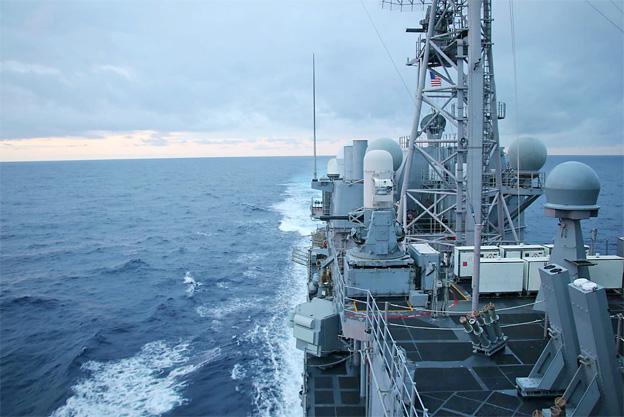The threat posed by China to Taiwan until 2030 is “critical,” US Director of National Intelligence Avril Haines said on Tuesday while testifying on worldwide threats at a hearing of the US Senate Committee on Armed Services.
“I think it’s fair to say that it’s critical, or acute,” Haines said when asked by US Senator Josh Hawley if she viewed the threat facing Taiwan to be acute from now until 2030.
“It’s our view that they [China] are working hard to effectively put themselves into a position in which their military is capable of taking Taiwan over our intervention,” she said, without elaborating.

Photo: AP
Beijing is closely watching the Russian invasion of Ukraine, which started more than two months ago, but it is unclear what lessons China might have learned since then, she said.
Whatever those lessons might be could affect China’s plan regarding Taiwan, but Russia’s invasion had not accelerated Beijing’s timeline, Haines said, citing US intelligence assessments.
US Defense Intelligence Agency Director Scott Berrier said he was “not seeing anything that would tell me that they’re [China] thinking about trying to take advantage of this time.”

Photo courtesy of US 7th Fleet
“We’re not really sure what lessons [Chinese President] Xi Jinping (習近平) is taking away from this conflict right now,” Berrier said. “We would hope that they would be the right ones.”
Hopefully, Xi would realize that an invasion of Taiwan would be difficult, dangerous and risky, Berrier added later.
Berrier and Haines said that China would rather pursue its unification goal through peaceful means than resorting to force, but Taiwan still needs to be prepared to defend itself militarily.
The US should engage with Taiwan’s military and leadership “to help them understand what this conflict has been about, what lessons they can learn,” Berrier said, referring to Ukraine’s resistance against Russian attacks.
The US should also help Taiwan grasp “where they should be focusing their dollars on defense and their training,” he said.
In related news, a US Navy warship sailed through the Taiwan Strait on Tuesday to show Washington’s “commitment to a free and open Indo-Pacific” region, the US Pacific Command’s 7th Fleet said in a statement.
The vessel, identified as the Ticonderoga-class guided-missile cruiser USS Port Royal (CG-73), made the transit as part of a “routine operation and was done in accordance with international laws,” the fleet said.
The 7th Fleet said that the ship transited through a corridor in the Taiwan Strait that is “beyond the territorial sea of any coastal state.”
“Port Royal’s transit through the Taiwan Strait demonstrates the United States’ commitment to a free and open Indo-Pacific” region, it said. “The United States military flies, sails and operates anywhere international law allows.”
The Ministry of National Defense later confirmed the transit, saying in a statement that the military was on top of the situation as the US warship sailed south through the Taiwan Strait and it did not see any irregularities.
On the same day of the transit, a Chinese attack helicopter briefly crossed the median line of the waterway, the ministry said.
The WZ-10 helicopter crossed the median line in a southern part of the Taiwan Strait on a mission with two KA-28 anti-submarine helicopters, it said.

TRAGEDY STRIKES TAIPEI: The suspect died after falling off a building after he threw smoke grenades into Taipei Main Station and went on a killing spree in Zhongshan A 27-year-old suspect allegedly threw smoke grenades in Taipei Main Station and then proceeded to Zhongshan MRT Station in a random killing spree that resulted in the death of the suspect and two other civilians, and seven injured, including one in critical condition, as of press time last night. The suspect, identified as a man surnamed Chang Wen (張文), allegedly began the attack at Taipei Main Station, the Taipei Fire Department said, adding that it received a report at 5:24pm that smoke grenades had been thrown in the station. One man in his 50s was rushed to hospital after a cardiac arrest

SAFETY FIRST: Double the number of police were deployed at the Taipei Marathon, while other cities released plans to bolster public event safety Authorities across Taiwan have stepped up security measures ahead of Christmas and New Year events, following a knife and smoke bomb attack in Taipei on Friday that left four people dead and 11 injured. In a bid to prevent potential copycat incidents, police deployments have been expanded for large gatherings, transport hubs, and other crowded public spaces, according to official statements from police and city authorities. Taipei Mayor Chiang Wan-an (蔣萬安) said the city has “comprehensively raised security readiness” in crowded areas, increased police deployments with armed officers, and intensified patrols during weekends and nighttime hours. For large-scale events, security checkpoints and explosives

PUBLIC SAFETY: The premier said that security would be tightened in transport hubs, while President Lai commended the public for their bravery The government is to deploy more police, including rapid response units, in crowded public areas to ensure a swift response to any threats, President William Lai (賴清德) said yesterday after a knife attack killed three people and injured 11 in Taipei the previous day. Lai made the remarks following a briefing by the National Police Agency on the progress of the investigation, saying that the attack underscored the importance of cooperation in public security between the central and local governments. The attack unfolded in the early evening on Friday around Taipei Main Station’s M7 exit and later near the Taipei MRT’s Zhongshan

ON ALERT: Taiwan’s partners would issue warnings if China attempted to use Interpol to target Taiwanese, and the global body has mechanisms to prevent it, an official said China has stationed two to four people specializing in Taiwan affairs at its embassies in several democratic countries to monitor and harass Taiwanese, actions that the host nations would not tolerate, National Security Bureau (NSB) Director-General Tsai Ming-yen (蔡明彥) said yesterday. Tsai made the comments at a meeting of the legislature’s Foreign Affairs and National Defense Committee, which asked him and Minister of National Defense Wellington Koo (顧立雄) to report on potential conflicts in the Taiwan Strait and military preparedness. Democratic Progressive Party (DPP) Legislator Michelle Lin (林楚茵) expressed concern that Beijing has posted personnel from China’s Taiwan Affairs Office to its